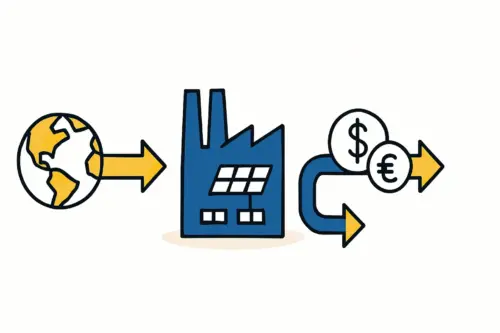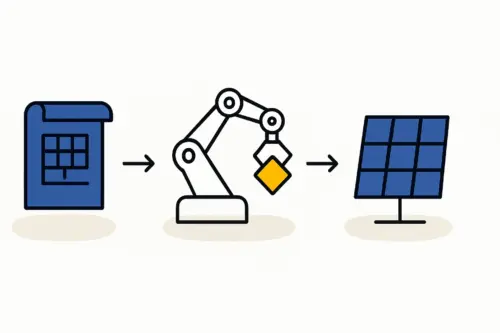It’s a profound irony: a state-of-the-art solar panel factory, capable of producing megawatts of clean energy technology, sits idle. Production lines are silent not from a lack of orders or materials, but because the local power grid has failed.
This scenario isn’t hypothetical—it’s a critical operational risk for entrepreneurs in many emerging markets.
A stable power supply is the lifeblood of any manufacturing enterprise. For a solar module factory where precision machines run continuously, an interruption is more than an inconvenience; it’s a direct threat to profitability and product quality. This article examines the challenges of operating in an unstable grid environment and outlines a strategic path to complete energy independence.
The High Cost of an Unreliable Grid: A Real-World Challenge
In many regions experiencing rapid economic growth, power infrastructure often lags behind industrial demand. In Madagascar, for instance, the national utility, JIRAMA, faces significant operational hurdles. The grid’s heavy reliance on aging and expensive thermal power plants leads to frequent, often lengthy, power outages.
For a business owner, these disruptions have tangible consequences:
- Financial Losses: Every hour of downtime translates to lost revenue. Production targets are missed, and order fulfillment is delayed, potentially damaging client relationships.
- Material Wastage: Certain stages of the solar panel manufacturing process, such as the lamination cycle, are time- and temperature-sensitive. A sudden power loss can ruin an entire batch of modules, resulting in significant material costs.
- Equipment Damage: Abrupt power cuts and subsequent surges can damage sensitive electronic components in a factory’s automated machinery, requiring expensive repairs and causing extended downtime.
- Operational Instability: The unpredictability of the grid makes production planning extremely difficult, hindering the factory’s ability to operate efficiently and scale effectively.
These challenges underscore a fundamental principle: relying solely on a volatile public grid is an unacceptable business risk.
Common Mitigation Strategies and Their Limitations
The most common solution for unreliable power is installing diesel generators. While they provide backup power and prevent total shutdowns, they come with their own set of significant drawbacks:
- High Operational Costs: Diesel fuel is a major and often volatile expense. In many landlocked or remote regions, fuel logistics add another layer of cost and complexity.
- Intensive Maintenance: Generators require regular, skilled maintenance to ensure they are ready to operate when needed.
- Environmental and Local Impact: Emissions, noise pollution, and the risks of fuel storage are considerable downsides, particularly for a business in the renewable energy sector.
While a diesel generator may be a necessary component of a backup strategy, relying on it as a primary solution is financially and operationally unsustainable.
A Strategic Solution: On-Site Power Generation and Storage
A far more robust and forward-thinking solution is for the factory to generate its own power. By leveraging the very technology it produces, a solar module factory can achieve complete energy independence, turning a critical vulnerability into a strategic strength. This approach relies on two core components.
The Role of a Rooftop Solar PV System
A factory building’s large, unobstructed roof is an ideal location for a solar photovoltaic (PV) installation. This system can be designed to meet the entire daytime energy demand of the production facility. By generating its own clean electricity on-site, the factory immediately reduces its dependence on the grid and eliminates exposure to fluctuating electricity tariffs and diesel fuel prices.
Ready to make big Profits?
The solar Industry is Booming
WE HELP NEWCOMERS to the solar industry start their own solar module production line. Customers can make BIG PROFITS by selling modules and finding investors, without wasting money and time on things they don't need!

Ensuring 24/7 Operations with Battery Storage
Solar panels generate electricity only during the day. A modern solar factory, however, often runs multiple shifts to maximize output and requires a consistent power supply around the clock. This is what makes a Battery Energy Storage System (BESS) essential.
A BESS stores excess solar energy generated during the day and discharges it at night or on overcast days, ensuring an uninterrupted power supply. This combination of a solar PV array and a BESS effectively creates a private, highly reliable microgrid for the factory, giving it complete independence from the unstable public utility.

The Business Case for Energy Independence
Investing in an on-site solar and storage system is not merely an operational expense—it’s a strategic investment in the long-term viability and profitability of the business. The business case is compelling:
- Cost Predictability: The factory’s electricity costs become fixed and predictable over the 25+ year lifespan of the solar system, shielding the business from rising grid tariffs and volatile fuel prices.
- Operational Resilience: Production is no longer at the mercy of the public grid. The factory can guarantee its production schedules, meet deadlines, and operate at maximum capacity, regardless of external power issues.
- Reduced Operating Expenses: Over time, the cost of generating on-site solar power is significantly lower than purchasing electricity from a fossil-fuel-dependent utility or running diesel generators.
- Brand Integrity: A solar panel factory powered by its own clean energy demonstrates a powerful commitment to its mission and product, enhancing its brand reputation.
Integrating this power solution from the outset is a critical element of a comprehensive solar panel manufacturing business plan. It transforms energy from a potential liability into a controllable asset.
Frequently Asked Questions (FAQ)
What exactly is a Battery Energy Storage System (BESS)?
A BESS is a large-scale rechargeable battery system that captures electrical energy, stores it, and then provides that energy to the factory when needed. It acts as a buffer, ensuring a smooth and constant power supply when the primary generation source—the sun—is unavailable.
How much factory roof space is required for a solar PV system?
The required area depends on the factory’s total energy consumption. As a general estimate, a 25–50 MW per year solar module factory might require a PV system of 300–600 kWp, which would occupy approximately 3,000 to 6,000 square meters of roof space.
Can this system be implemented in an existing factory?
Yes, a solar-plus-storage system can be retrofitted onto an existing facility. A structural assessment of the roof is necessary to ensure it can support the weight of the solar panels, but this is a very common and feasible upgrade.
Is it possible to sell excess electricity back to the grid?
This depends entirely on local regulations and the technical capabilities of the local grid. In some markets, feed-in tariffs or net metering programs allow businesses to sell surplus power, creating an additional revenue stream. In regions with unstable grids, however, the primary goal is typically self-sufficiency rather than exporting power.
Conclusion: Turning an Operational Risk into a Competitive Advantage
For entrepreneurs planning to enter the solar manufacturing sector, the question is not whether they can afford to invest in an independent power solution, but whether they can afford not to. In an environment with an unreliable grid, planning for energy self-sufficiency is a foundational pillar of a successful enterprise.
By integrating a properly sized solar PV system and a battery energy storage solution, a factory owner can eliminate one of the most significant operational risks and create a resilient, efficient, and highly competitive manufacturing facility. This foresight is a key step for any entrepreneur learning how to start a solar panel factory that’s built to last.







